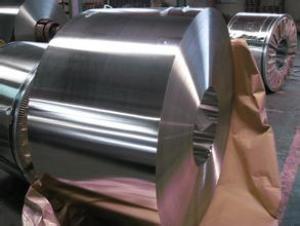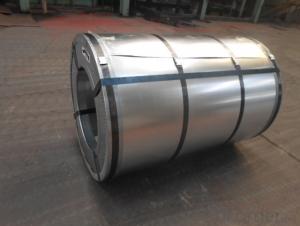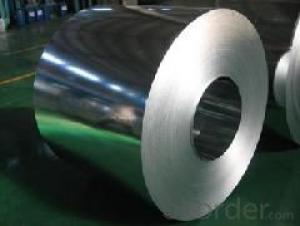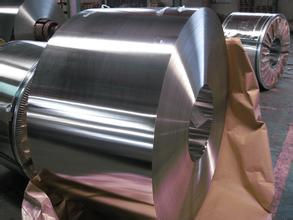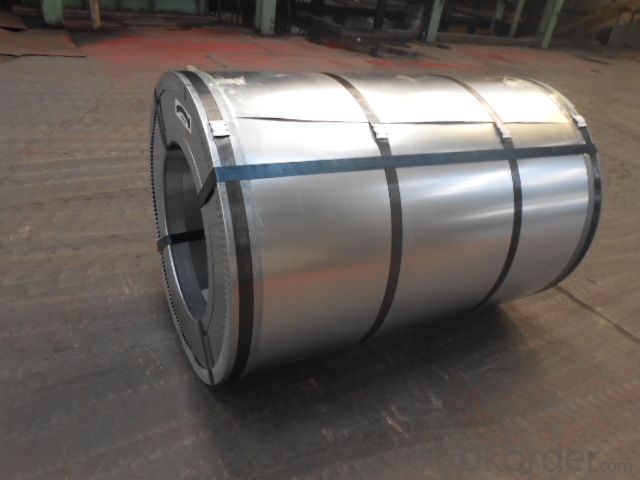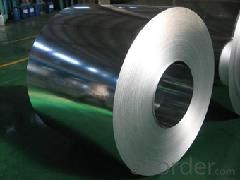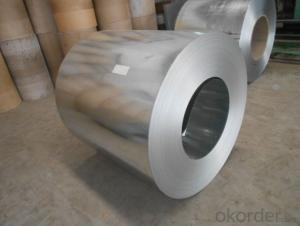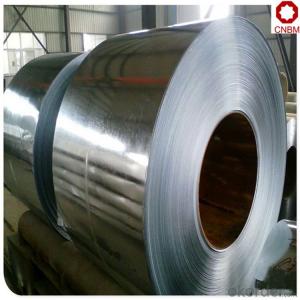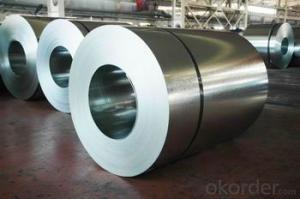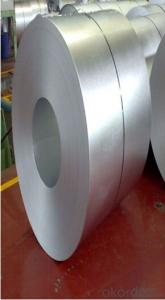Hot-Dip Galvanized Steel Coil Good Quality
- Loading Port:
- Shanghai
- Payment Terms:
- TT OR LC
- Min Order Qty:
- 50 m.t.
- Supply Capability:
- 10000 m.t./month
OKorder Service Pledge
OKorder Financial Service
You Might Also Like
1. Hot-Dip Galvanized Steel Coil Description:
Hot-dip galvanized steel coil are available with a pure zinc coating through the hot-dip galvanizing process. It offers the economy, strength and formability of steel combined with the corrosion resistance of zinc. The hot-dip process is the process by which steel gets coated in layers of zinc to protect against rust. It is especially useful for countless outdoor and industrial application.
2.Main Features of the Hot-Dip Galvanized Steel Coil:
• Excellent process capability
• Smooth and flat surface
• Workability, durability
• Excellent heat resistance performance
• High strength
• Good formability
• Good visual effect
3.Hot-Dip Galvanized Steel Coil Images

4.Hot-Dip Galvanized Steel Coil Specification
Standard: AISI, ASTM, BS, DIN, GB, JIS
Grade: SPCC, SPCD, Q195, DX51D
Thickness: 0.15-5.0mm
Model Number: coil
Type: Steel Coil
Technique: Cold Rolled
Surface Treatment: Galvanized
Application: Container Plate
Special Use: High-strength Steel Plate
Width: 600-1250mm
Length: depends
commodity: hot dipped galvanized steel coil
technique: cold rolled
thickness: 0.15-5.0mm
width: 600-1500mm
surface treatment: galvanized
zinc coating: 50-275g/m2
coil weight: 3-7 tons
coil ID: 508/610mm
spangle: zero spangle, regular spangle, small spangle, big spangle
payment term: by L/C or T/T
5.FAQ of Hot-Dip Galvanized Steel Coil
What’s the application of this product?
There are many applications for this product. For example, roofing, cladding, decking, tiles, sandwich walls, etc.
What’s the coating composition of Hot-Dip Galvanized Steel Coil?
The coating composition is 55% aluminium in weight ratio, 43.4% zinc, and 1.5% silicon, with excellent corrosion and heat resistance performance.
- Q: What are the factors driving the growth of the steel coil industry?
- There are several factors driving the growth of the steel coil industry. Firstly, the increasing demand for steel coils in various sectors such as automotive, construction, and manufacturing is a significant driver. Additionally, the expanding infrastructure projects and urbanization in emerging economies contribute to the growth of the industry. Moreover, technological advancements in steel manufacturing processes and the adoption of efficient production techniques also play a crucial role in driving the growth of the steel coil industry.
- Q: I'm sort of a sword maker. You could say I'm an amateur blacksmith. I want to find a dependable source of high-grade steel. I've made a few blades and from what I know about the difference between true steel and cheap steel, I have yet to work with such. All of the metal I have used could not have been true high carbon spring steel because while they are hard, their properties do not reflect that of true steel. I would sincerely appreciate any guidance on where I could order some fine-quality steel so I could produce a truly fine blade.
- You have already a good answer, but you have to bear in mind that in your work you need to follow the correct procedure for heat treatment. That procedure is dependent on the type of steel you have picked on.
- Q: How do steel coils contribute to energy efficiency in appliances?
- Steel coils contribute to energy efficiency in appliances in several ways. Firstly, steel coils are commonly used in the heat exchangers of appliances such as refrigerators, air conditioners, and water heaters. These coils transfer heat efficiently, allowing appliances to cool or heat the desired space using less energy. By maximizing heat transfer, steel coils help appliances reach the desired temperature faster and maintain it with minimal energy consumption. Secondly, steel coils are often used in the heating elements of appliances like stoves and ovens. These coils provide direct heat to cook or bake food. Steel's excellent thermal conductivity ensures that the heat is evenly distributed, reducing cooking time and energy consumption. This allows appliances to work more efficiently, saving both time and energy. Furthermore, steel coils are durable and long-lasting, which contributes to energy efficiency in appliances. Appliances with steel coils are built to withstand high temperatures and frequent use. This means they require less maintenance and replacement, resulting in fewer resources being used to produce new appliances. By reducing waste and conserving resources, steel coils indirectly contribute to energy efficiency and sustainability. Lastly, steel is a recyclable material. When appliances reach the end of their life cycle, the steel coils can be recycled and used to produce new products. Recycling steel reduces the need for extracting raw materials and saves energy that would otherwise be required in the manufacturing process. This promotes energy efficiency and reduces the environmental impact of appliances. In conclusion, steel coils contribute to energy efficiency in appliances by optimizing heat transfer, reducing cooking time, promoting durability, and facilitating recycling. These factors collectively help appliances operate more efficiently, save energy, and contribute to a more sustainable future.
- Q: Does anyone know what is 12 gage Cold Rolled Steel meaning? Also, help me to describe it.Thank you so muck ~!Mark Lin
- Steel thickness is measured by gages. 16 gage is approximately 1/16th of an inch. The larger the number (say, 24), the thinner the steel. Steel is made from large metal bars (4'x12', about 8 thick) that pass through presses to get thinner and thinner. If the final stages of rolling are done with pressure and not heat, it is cold rolled. It often gets galvanized to prevent rusting. Hope this helps.
- Q: What are the different types of steel finishes for coil protection?
- There are several types of steel finishes used for coil protection, including galvanized, painted, and coated finishes. Galvanized steel is coated with a layer of zinc to protect against corrosion. Painted steel is coated with a layer of paint for aesthetics and additional protection. Coated finishes can include various types such as epoxy, polyurethane, or polyester, which provide different levels of durability and resistance to corrosion.
- Q: I remember my dad saying something about steel toed boots but I forgot =#92; I went and checked out all the stores and got a pair with good ankle support but they also have steel toes. Would this interfere with the shifter or anything? I figure if anything my dirt bike shoes have the steel toes too. Any opinion?
- My work boots are steel caps i ride to work and home in them. I also wear them when I'm too lazy to change into my proper boots.I don't see any dramas with you wearing them they do come in handy for dogs that try to latch onto you. Ride safe.
- Q: i want to know if i should buy a set of acrylic tapers or steel. they r close in cost so it's not a money factor i want to know which work better and if there is a downside to either. thanks!
- It relies upon on your physique and what you desire. in case you physique is allergic to a minimum of one in all them you may would desire to chosen for yet another one. If this is not any longer allergic to any, than you need to use in spite of you like the main, in simple terms attempt the two.
- Q: How are steel coils used in the manufacturing of railway tracks?
- Steel coils are used in the manufacturing of railway tracks as they are processed into long, continuous lengths of steel rails. These coils are first uncoiled and then passed through a series of machines that shape, cut, and weld them together to form the required lengths and profiles of railway tracks.
- Q: How are steel coils transported internationally?
- Steel coils are typically transported internationally by sea, as they are usually too heavy and bulky to be transported by air. The most common method of transportation is by using specialized shipping containers known as flatracks or open-top containers. These containers allow for easy loading and unloading of the steel coils onto the vessel. Before transportation, the steel coils are usually securely strapped or banded together to prevent any movement or damage during transit. They are then loaded onto the flatracks or open-top containers using cranes or forklifts. The coils are carefully placed and secured onto the containers to ensure stability and to prevent shifting during the journey. Once loaded, the containers are sealed and transported to the nearest port, where they are loaded onto cargo ships. These ships are specifically designed to transport heavy and oversized cargo. They are equipped with specialized handling equipment such as cranes and ramps to facilitate the loading and unloading of the containers. During the journey, the cargo ships follow predetermined shipping routes to reach the destination port. The duration of the journey depends on the distance between the origin and destination ports. Steel coils are typically transported in large quantities, so multiple containers may be loaded onto a single ship. Upon arrival at the destination port, the containers are unloaded from the cargo ship using cranes or ramps. The steel coils are then carefully removed from the containers and transported to their final destination, which may involve further transportation by road or rail. Throughout the transportation process, it is crucial to ensure that the steel coils are adequately protected from moisture, corrosion, and other potential damages. Special attention is paid to the handling and stowage of the coils to minimize the risk of any structural damage or deformation. In summary, steel coils are transported internationally by sea using specialized shipping containers. The coils are securely loaded onto flatracks or open-top containers, which are then transported by cargo ships to the destination port. Proper handling and stowage techniques are employed to ensure the safe and secure transportation of the steel coils.
- Q: Can steel coils be used in the production of packaging materials?
- Yes, steel coils can be used in the production of packaging materials. Steel coils are commonly used to manufacture metal packaging materials such as cans, containers, and drums. The strength and durability of steel make it an excellent choice for packaging materials that require protection and stability. Additionally, steel coils can be easily shaped and formed to meet specific packaging requirements, making them versatile for various applications in the packaging industry.
Send your message to us
Hot-Dip Galvanized Steel Coil Good Quality
- Loading Port:
- Shanghai
- Payment Terms:
- TT OR LC
- Min Order Qty:
- 50 m.t.
- Supply Capability:
- 10000 m.t./month
OKorder Service Pledge
OKorder Financial Service
Similar products
Hot products
Hot Searches
Related keywords
